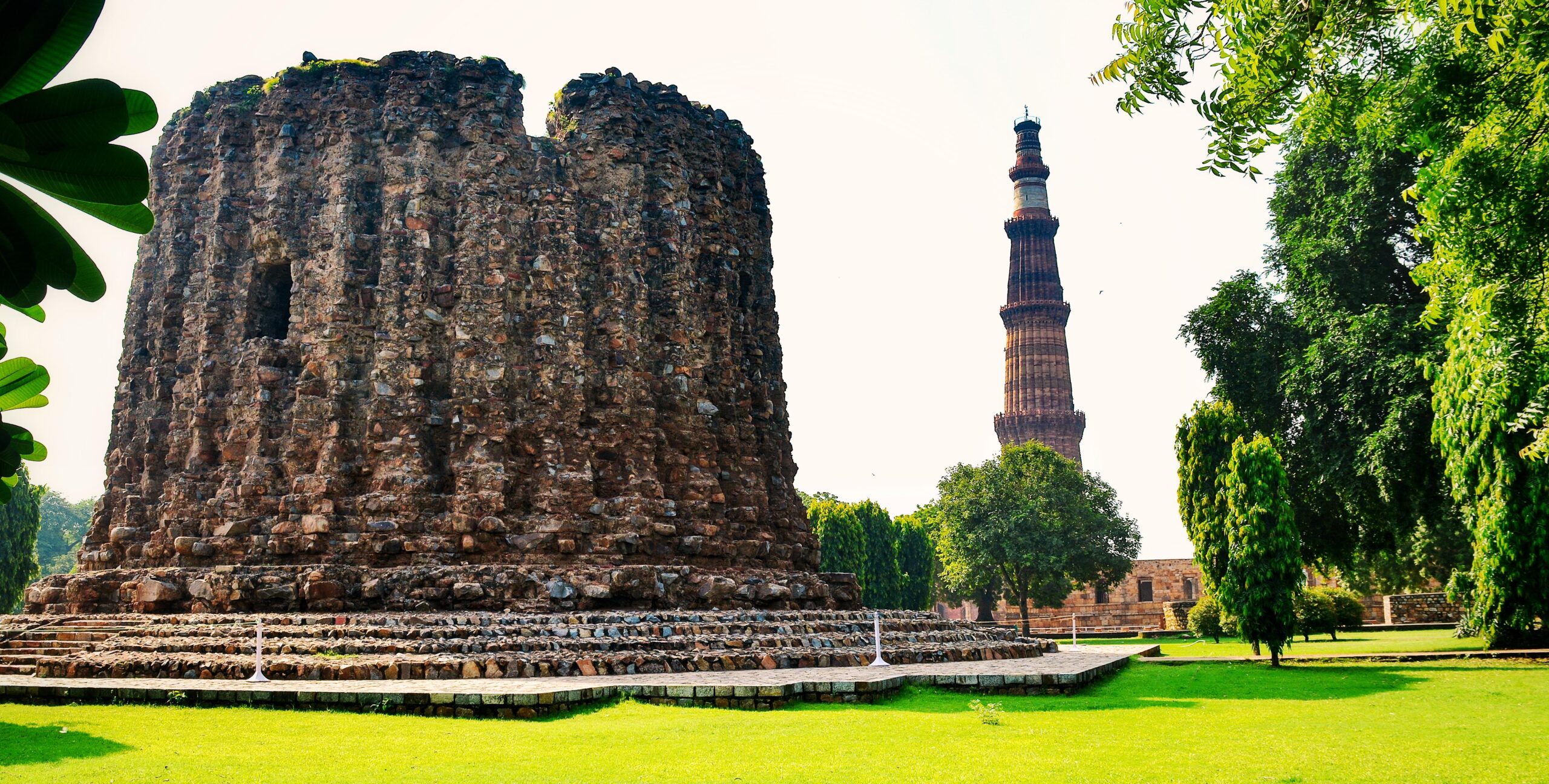
Qutub Minar A Silent Dialogue Between History Mystery
Qutub Minar is one of the most iconic historical monuments in India, located in Delhi. Here’s a quick overview:
Qutub Minar Overview
Location: Mehrauli, Delhi, India
Height: 72.5 meters (238 feet)
Construction Started: 1192 CE
Built By: Qutb-ud-din Aibak (founder of the Delhi Sultanate)
Completed By: Iltutmish and later rulers
Material Used: Red sandstone and marble
UNESCO World Heritage Site: Since 1993
Architecture
Style: Indo-Islamic architecture
Structure: Five distinct storeys, each marked by a projecting balcony
Decorations: Intricate carvings and Quranic inscriptions
Tilt: The tower has a slight tilt, but it is stable
Surrounding Complex
Quwwat-ul-Islam Mosque – The first mosque built in India
Iron Pillar of Delhi – A 7-meter iron pillar that has not rusted in over 1,600 years
Alai Minar – An incomplete tower that was meant to be twice the height of Qutub Minar
Tombs and gateways – Including those of Iltutmish and Alauddin Khilji
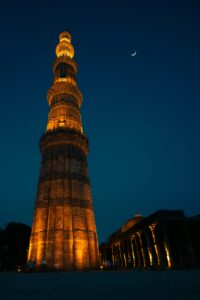
Historical Background of Qutub Minar
1. Foundation by Qutb-ud-din Aibak (1192 CE)
Qutb-ud-din Aibak, a general of Muhammad Ghori and later the founder of the Delhi Sultanate, started the construction of Qutub Minar in 1192.
He built the first storey of the tower as a victory tower after defeating the Rajput rulers and establishing Muslim rule in Delhi.
It was also meant to serve as a minaret attached to the Quwwat-ul-Islam Mosque, the first mosque built in India after the Islamic conquest.
2. Completion by Iltutmish (1220 CE)
Aibak died before the tower could be completed. His son-in-law and successor, Shams-ud-din Iltutmish, added three more storeys, completing most of the structure around 1220 CE.
3. Damage & Repairs
The minar suffered lightning and earthquake damage multiple times:
1369 CE: A lightning strike destroyed the top storey. Firoz Shah Tughlaq rebuilt the damaged part and added the fifth and final storey, using marble and sandstone.
1505 CE: An earthquake caused damage again, and repairs were done by Sikandar Lodi.
1803 CE: A major earthquake damaged the tower; the British restored it during the early 19th century. Major Robert Smith even added a cupola on top (which was later removed and placed nearby).
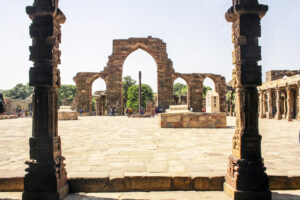
Symbolism and Significance
Symbol of victory: Qutub Minar was built to celebrate the victory of Islam in India.
Religious and cultural fusion: The surrounding complex shows a fusion of Hindu, Jain, and Islamic architectural elements, as many parts of the mosque were built using materials from demolished Hindu and Jain temples.
Iron Pillar of Delhi: A testament to ancient Indian metallurgy, this 4th-century artifact stands within the complex and has not rusted for over 1600 years.
Modern Recognition
UNESCO World Heritage Site (1993) for its cultural significance and architectural grandeur.
One of the most visited monuments in India.
Qutub Minar remains a symbol of Delhi’s layered history—from Rajput to Sultanate to Mughal to British colonial rule.
The Complete Story of Qutub Minar, Delhi
Origins: The Birth of a Monument (1192 CE)
The story of Qutub Minar begins in 1192 CE, when Qutb-ud-din Aibak, a Turkic general in Muhammad Ghori’s army, defeated the Rajput king Prithviraj Chauhan and laid the foundation of the Delhi Sultanate.
To mark his victory and the arrival of Islamic rule in India, Aibak began the construction of a monumental victory tower — the Qutub Minar — named either:
After himself, or
In honor of his spiritual mentor, Khwaja Qutb-ud-din Bakhtiar Kaki, a Sufi saint of Delhi.
He also commissioned the Quwwat-ul-Islam Mosque — meaning “Might of Islam” — the first mosque built in India.
Aibak managed to build only the first storey of the tower before he died in 1210.
The Successors: Completion & Expansion (1220 CE)
Iltutmish (r. 1211–1236)
Aibak’s son-in-law and successor, Iltutmish, added three more storeys, making the minaret a towering symbol of Muslim power.
His work followed Aibak’s red sandstone style but introduced more refined carvings and calligraphy.
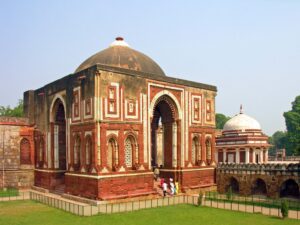
Firoz Shah Tughlaq (r. 1351–1388)
In 1369, a lightning strike destroyed the top storey.
Firoz Shah restored the minar and added the fifth and final storey, using a combination of white marble and red sandstone, giving it a unique two-toned appearance.
Disasters & Restorations
The Qutub Minar has faced the test of time — and nature:
Year Disaster Restoration
1369 Lightning Repaired by Firoz Shah Tughlaq
1505 Earthquake Repaired by Sikandar Lodi
1803 Earthquake Repaired by the British
1828 British officer Major Robert Smith installed a cupola on top (later removed in 1848 and placed beside the minar)
The Qutub Complex: More Than Just a Tower
The Qutub Minar is the centerpiece of a larger historical complex that reflects a blend of cultures, religions, and architectural styles:
1. Quwwat-ul-Islam Mosque
Built using materials from 27 dismantled Hindu and Jain temples.
Shows early Indo-Islamic architecture, with intricate stone carvings featuring both Islamic calligraphy and Hindu motifs.
2. Iron Pillar of Delhi
A 7.2-meter iron pillar, dated to the 4th century CE, originally from the Gupta Empire.
Remarkably rust-resistant, it’s one of the oldest metallurgical wonders in the world.
3. Alai Minar
An ambitious project by Alauddin Khilji who wanted to build a minar twice the height of Qutub Minar.
Only the base (27m) was completed before his death; it still stands as a massive, unfinished structure nearby.
4. Tombs & Gateways
Includes the tombs of Iltutmish, Alauddin Khilji, and others.
The Alai Darwaza, a gateway built by Alauddin, is a masterpiece of Indo-Islamic architecture.
Book Now
Architecture & Design
Feature Detail
Height 72.5 meters (238 feet)
Storeys 5 storeys, each with a projecting balcony
Diameter 14.3m at the base, tapering to 2.7m at the top
Materials Red sandstone (lower floors), marble + sandstone (top floor)
Carvings Arabic inscriptions, floral motifs, geometric patterns
Style Early Indo-Islamic with Persian and local influences
Each floor is separated by a projecting balcony supported by elaborately decorated brackets.
Legacy and Modern Status
UNESCO World Heritage Site since 1993
Among the most visited tourist sites in India
A symbol of Delhi’s layered history: Hindu → Islamic → Colonial → Modern
Surrounded by lush gardens, and now part of Mehrauli Archaeological Park
Symbolism
Qutub Minar is more than a minaret — it’s a symbol of conquest, spiritual devotion, architectural brilliance, and cultural fusion.
For the Sultanate rulers: It was a sign of Islamic dominance and religious zeal.
For historians: It represents the transition from Indian to Indo-Islamic architecture.
For modern India: A monument that encapsulates centuries of history, conflict, coexistence, and creativity.
In Summary
The Qutub Minar is not just a tower — it’s a chronicle in stone.
From the foundation of Islamic rule to the blend of diverse architectural traditions, it tells the story of India’s medieval era, its conquests, its craftsmen, and its continuity through centuries of change.

Mysteries of Qutub Minar, Delhi
1. Who Really Built the Qutub Minar?
Officially, Qutub Minar was built by Qutb-ud-din Aibak in 1192 CE.
But some historians and archaeologists suggest it may have pre-Islamic origins or may have been constructed over a Hindu or Jain tower.
The base of the tower and parts of the Quwwat-ul-Islam mosque were clearly built using materials from 27 demolished Hindu and Jain temples.
Theory: Some believe the Minar could have been a repurposed ancient tower — similar to how temples were converted into mosques in the medieval period.
2. The Rust-Free Iron Pillar
The Iron Pillar, located within the Qutub complex, is over 1,600 years old, believed to have been built during the Gupta Empire.
Despite being made of 99.7% pure iron, it has not rusted — even after centuries of exposure to the elements.
Scientists are still studying this to understand the ancient metallurgical techniques. The exact reason for its corrosion resistance is still partially debated.
3. The Incomplete Alai Minar
Alauddin Khilji started constructing a tower twice as tall as the Qutub Minar — the Alai Minar.
But after his death in 1316, the project was abandoned, and only the first 27-meter-high base remains.
Mystery: Why did no future ruler complete it? Was it a political decision or a sign of bad omen?
4. Architectural Anomalies
The base diameter of Qutub Minar is much wider than usual for Islamic minarets, suggesting it may have had a different original purpose.
Some carvings appear incomplete, and certain stones seem out of place, indicating reconstruction or reuse of older structures.
Some believe the tower might have originally been a Vedic astronomical observatory or even a Vishnu Dhwaja (flagstaff of Vishnu).
5. The Missing Cupola
In 1828, British officer Major Robert Smith added a cupola (chhatri) on top of the Qutub Minar.
But in 1848, it was removed by Lord Hardinge, who called it “architecturally inappropriate,” and it now stands on the ground nearby.
Rumor: Some say the British did it to change the original appearance and claim symbolic ownership.
Book Your Trip Now
6. Underground Chambers & Hidden Passages
Local legends speak of secret tunnels, underground chambers, and hidden treasures beneath the Qutub complex.
However, these remain unverified due to lack of open excavation in recent times.
Some areas of the complex are permanently closed to the public, further fueling speculation.
7. Deaths and the Closing of the Tower
In 1981, around 45 people, mostly schoolchildren, died in a stampede inside the tower after a power failure caused panic.
Since then, entry into the tower has been closed to the public.
Locals whisper about paranormal sightings or eerie vibes inside the minar, though no official source supports this.
8. Hindu Symbolism in an Islamic Monument
Many pillars and walls in the Qutub complex feature Hindu deities, lotus motifs, and temple-style carvings.
These are believed to be remnants of the Hindu and Jain temples that once stood on the site.
Some speculate that Qutub Minar was a reconstruction over a former temple pillar, adding to its complex, multi-religious past.
Final Thoughts
The Qutub Minar is more than just a monument — it’s a historical puzzle.
Every stone tells a story, and every unanswered question adds to its mystery.
Whether it was a victory tower, an observatory, or something else, it continues to capture imaginations centuries later.
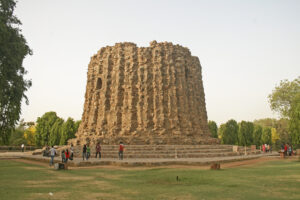
The Incomplete Alai Minar: Behind the Story
Who Built It?
The Alai Minar was commissioned by Alauddin Khilji, the powerful Sultan of Delhi (r. 1296–1316), who belonged to the Khilji dynasty. Known for his military conquests and administrative reforms, Alauddin wanted to immortalize his reign with a grand architectural statement.
The Ambition
Alauddin Khilji wanted to build a victory tower twice the height of the Qutub Minar, which was already an imposing 73 meters.
The Alai Minar was meant to surpass Qutub Minar as a symbol of his power, glory, and the might of the Khilji dynasty.
It was intended to be the tallest minaret in the world at that time — a true architectural marvel and a symbol of Islamic dominance and imperial ambition.
Construction and Style
Construction started around 1296 CE.
The design followed the same tapering minaret style but was planned on a much grander scale.
Unlike the Qutub Minar’s predominantly red sandstone, Alai Minar’s base is made of massive rough stones, giving it a solid, fortress-like appearance.
The base that was built is about 27 meters high, which is already huge but only about one-third of the planned final height.
Why Was It Left Incomplete?
The project was abandoned abruptly after Alauddin Khilji’s death in 1316.
His successors, including his son Qutb-ud-din Mubarak Shah, were either unable or unwilling to continue the grand project.
Possible reasons for abandonment:
Political instability and power struggles after Alauddin’s death.
Financial constraints or shifting priorities of the new rulers.
The massive scale and engineering challenges of the structure may have discouraged continuation.
What Remains Today?
Only the large, circular base of the Alai Minar stands today in the Qutub complex.
It looks like a giant stone drum, looming unfinished and dwarfing the nearby structures.
This base serves as a reminder of Alauddin’s grandiose plans and the limits of medieval ambition.
Legacy and Significance
The incomplete Alai Minar is a symbol of unfulfilled ambition — a powerful visual metaphor for the ephemeral nature of human power.
It contrasts with the elegant and complete Qutub Minar nearby, highlighting how history favors some visions over others.
Despite being unfinished, it remains a major point of interest for historians, archaeologists, and tourists alike.
In Summary
Aspect Details
Builder Alauddin Khilji
Started Around 1296 CE
Intended Height Twice Qutub Minar (around 140+ m)
Actual Height Built About 27 meters
Reason for Abandonment Death of Alauddin + successors’ priorities
Current Status Massive stone base, unfinished
Note- Qutub Minar A Silent Dialogue Between History Mystery ? Do tell us in the comment box below. Your opinion is very important to us.
Book Your Trip Now

One thought on “Qutub Minar A Silent Dialogue Between History Mystery”